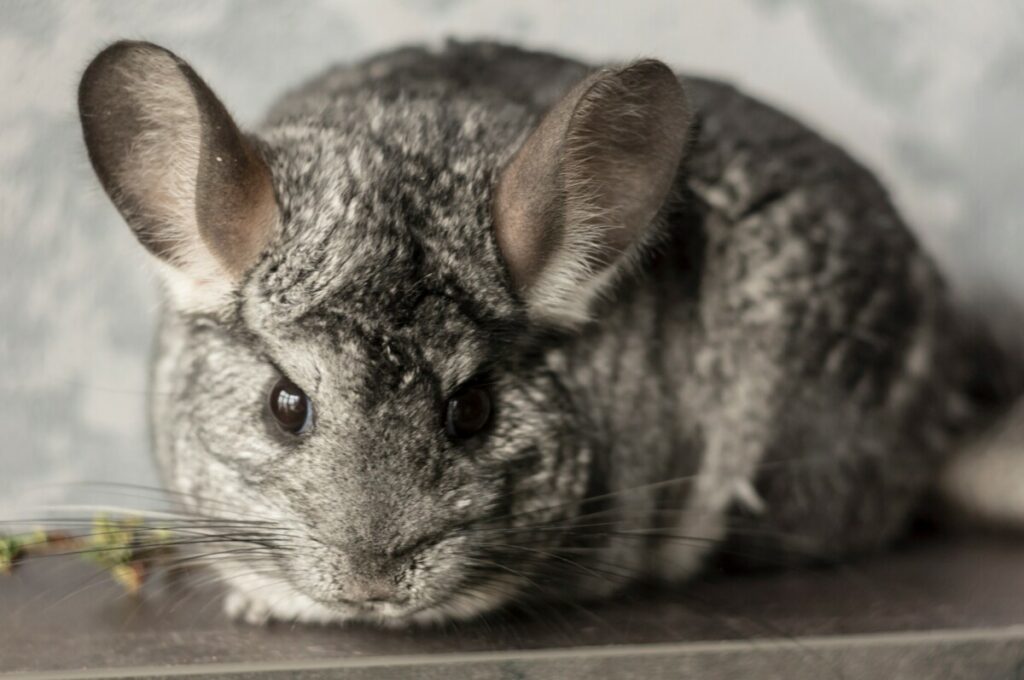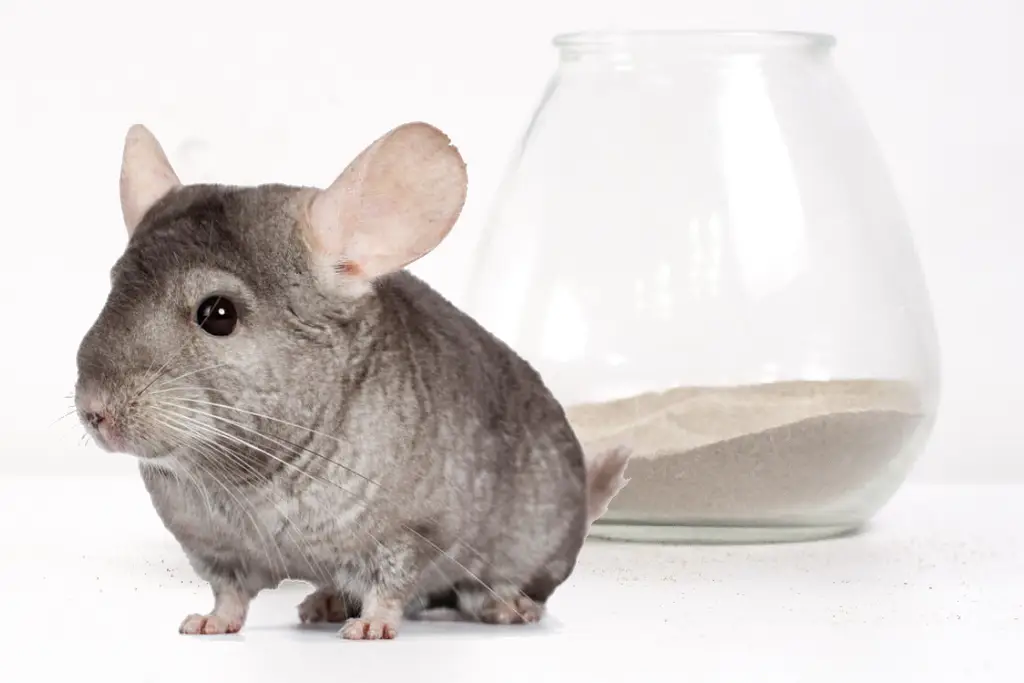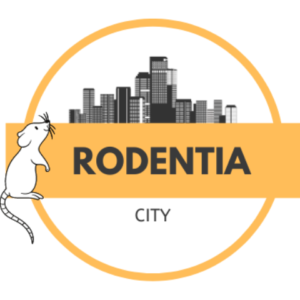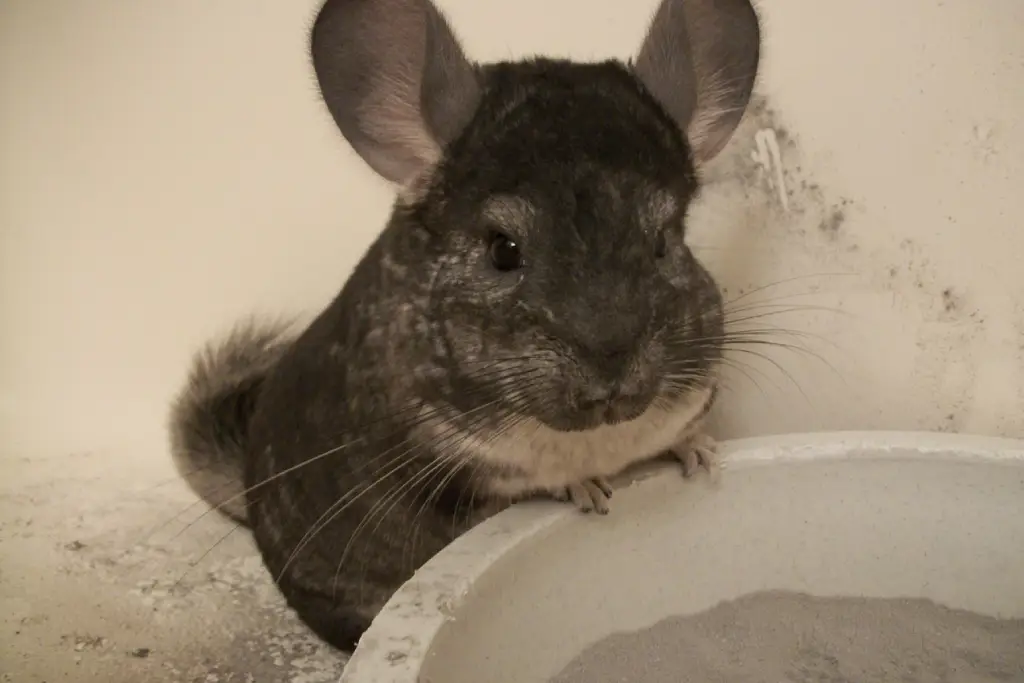It is no secret that furry little chinchillas are widely considered to be among the cutest of animals alive. Their soft and thick fur coats make them look more like a fuzzy pillow than an animal! One of the most curious things about chinchillas is how they go about grooming themselves.
Because of their thick hair density and naturally oily skin, chinchillas cannot take a regular bath with water. However, they need to remove excess oil, so they roll around in volcanic dirt every few days to help keep their skin from becoming too oily.
It is entertaining to watch a chinchilla give itself a dust bath. However, they don’t roll in the dirt just for fun. Below we talk about why chinchillas take dust baths and how often they should do so.
What is a Chinchilla Dust Bath?
The density of chinchilla hair causes moisture to become trapped near their skin, including excess oils and any kind of moisture to which they are exposed. For this reason, chinchillas need to wash in a way that does not involve water, as a traditional bath will be difficult for their skin to handle. To avoid this, chinchillas are known to take what are known as “dust baths” as a way of grooming themselves and removing these excess oils.
When a chinchilla takes a dust bath, they roll around in the dust and covers its entire body. While this may seem odd to humans, chinchillas do this because it is a fast way to groom themselves. They do this so that the loose dirt and dust can go in between their hair. The dirt and dust absorb excess oils and water. After their dust bath is finished, chinchillas shake off most of the excess dust so they are nice and clean.
Chinchillas also roll around in the dust and volcanic ash to feel at home, as they are native to western South America.
Why Do Chinchillas Take Dust Baths?

Chinchillas claim the title of having the most densely packed fur of any mammal on Earth. While humans only have one hair per hair follicle, chinchillas’ hair follicles have from 50 to 70 individual hairs that can grow from each follicle! Chinchillas have about 20,000 hairs per square inch.
While their thick, dense hair is good at keeping chinchillas warm, it also traps all moisture right next to the skin and doesn’t let water escape. For this reason, it is best for chinchillas to not get wet or have much exposure to water. Getting their fur wet will make it incredibly difficult to dry them off completely, and having water stuck against their skin and sitting at the base of their hair is not good for the health of any chinchilla. If a chinchilla’s fur is wet for a long period of time, its skin can get infected because of fungi growth.
Even though moisture is not good for the chinchillas, their bodies take care of moisturizing their skin and keeping it healthy. Chinchillas have naturally oily skin that keeps their skin moisturized even in dry mountain air. While this oil is very good for their bodies, it is not easy for chinchillas to wash out excess oil due to the density of their hair. One of the main reasons why chinchillas take dust baths is to remove this excess oil without introducing extra and unnecessary moisture to their skin and hair.
How Often Do Chinchillas Take Dust Baths?
Chinchillas take dust baths every couple of days. In fact, chinchillas can take dust baths up to 4 times every week. However, exactly how often your chinchilla needs to take a dust bath varies depending on the weather.
If it is extremely warm outside, the heat will cause your chinchilla to sweat, which will make their skin more oily than normal. When it is hot outside, your chinchilla will need to take more dust baths than normal.
On the other hand, if it is cold outside, your chinchilla will need to take fewer dust baths. Don’t give your chinchilla dust baths too often, as they can dry out their skin.
Luckily, it is easy to determine whether or not your chinchilla needs a dust bath. If your chinchilla’s fur looks oily, they need a dust bath as soon as possible. If it has been a few days since your chinchilla last took a dust bath, give them the option to take one. If your chinchilla doesn’t take a dust bath, they likely don’t need one.
However, if your chinchilla’s fur looks oily and they refuse to take a dust bath, it might not be feeling well. Contact the vet and determine if you need to take your chinchilla in for a vet visit.
What Kind of Dust Do Chinchillas Use?

In their natural habitat, the dust that chinchillas will use to bathe is often made out of volcanic ash and pumice, which is a type of volcanic rock broken down into finer pieces. However, volcanic ash is not often available for people to purchase, which can make it difficult for chinchilla owners to get their pets to take a dust bath.
Luckily, you can use chinchilla dust instead. Chinchilla dust only costs about $10-$15, which is good because you will need a lot of it to keep your chinchilla happy.
Do’s and Don’ts of Chincilla Baths
Do’s
Do allow your chinchilla to take a dust bath on their own. They will roll around until their skin feels good again, and if they are still taking a dust bath after you think they should be done, they likely still need to get dust into the crevices of their fur. It typically takes 5-15 minutes for chinchillas to take a dust bath.
Do change the dust regularly. If the dust that your chinchilla is taking a dust bath in is clumpy or oily, throw it away and replace it with new chinchilla dust.
Don’ts
Don’t buy an extremely small dust bath house. If the dust bath house you purchase is too small and doesn’t allow your chinchilla to roll around properly, your chinchilla won’t get properly cleaned and might get skin infections.
Don’t let your chinchilla take a dust bath too often. If your chinchilla’s skin seems to be dry or if they seem to be more itchy than normal, limit the number of dust baths that they are taking.
Recent Posts
Just like pretty much all rodents, chinchillas need to chew on things to keep their teeth at a healthy length. They love to chew on wood, but not all kinds of wood are good for them. So, which types...
Are you looking for things to feed your little friend? If you are thinking about putting spinach in your guinea pigs diet, but aren't sure whether it is the right source of nutrients you have come to...

